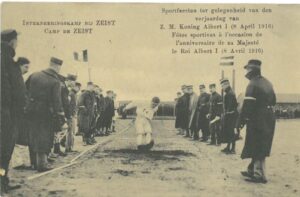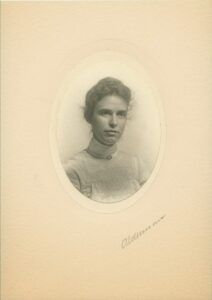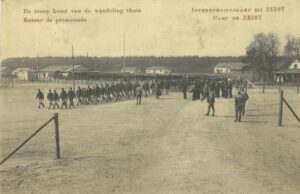During World War I, many young American women became pen pals with European prisoners of war. This was the case with Miss Melville Fort, an art teacher at the State Normal and Industrial College (now UNC Greensboro). Like many of the women who taught college in the early 20th century, Miss Fort was strongly committed to the education of the young students in her charge. A native of Mississippi, she was known as an intelligent and witty teacher and a good friend, but we know very little about her social life. In fact, we know very little about Miss Fort at all, but we can glean a bit of her nature from several letters and postcards that she received from a Belgian prisoner of war in 1917.
Miss Fort participated in a British program in which Americans were able to write POWs in Europe. Programs such as these provided interred men with a link to the outside world, and a way for Americans to “give back” to the war effort. Although Miss Fort corresponded with two men, her correspondence with Arthur Limbosch was the most substantial. As his letters provide a response to Miss Fort’s correspondence, her interests and compassionate nature become apparent. She shared a little about her profession and her love of travel with him, commenting that she had been to Holland. In turn, he described the beauty of his country and his fear that it would be destroyed by “the Huns.”
Arthur was only seventeen years old when the war began. He had been an electrician living with his parents in Brussels and by his own account, was very inexperienced. As there were sufficient electricians in his military unit, he was made a “telephonist.” In his letters, Arthur recounted his involvement in the Siege of Antwerp in October of 1914. He expressed the horrors of war though the death of his friends and comrades, the lack of food, and his fear of the enemy. Arthur was surprisingly candid about how his battalion was besieged by the Germans and subsequently retreated.
Like many young men, Arthur was captured and forced to live in an internment camp. The official name of this site was “Internment Camp Amersfoot – near Zeist,” but was usually shortened to just “Zeist.” In his letters to Miss Fort, Arthur described the grounds and the “shed” in which he lived. Zeist was actually two camps that consisted of twenty-four barracks within an approximate square mile area, housing up to 15,000 men. It was surrounded by barbed wire and the prisoners were given little freedom, although they were allowed to take walks around the area before they retired for the night. Every other day, they were granted permission to walk in the woods, guarded by Dutch sentries. The camp also included sports grounds, and Arthur told Miss Fort that he played football (soccer) on these athletic fields. He also described dining on potatoes and beans – and sometimes a few vegetables and a little meat.
 |
| Prisoner participating in an athletic event at Camp Zeist, from a postcard sent to Miss Fort by Arthur Limbosch |
Through the several surviving letters, we see that she became an immediate favorite with Arthur and the other prisoners by sending stamps for their stamp collections. Arthur was also thrilled to find Miss Fort was a teacher and asked if he could practice his English through their correspondence. He insisted she correct any mistakes in his letters, as he was attempting to master a language that he considered much different from his. He made a special point of telling her that he had not learned English in school, but had picked it up during the time he was a prisoner. Arthur was also quick to correct her assumption that the European schools were more advanced than their American counterparts.
Although their correspondence was limited to only a few letters and postcards, it reveals an interesting slice of history, which for a brief time, allowed an electrician from Brussels and an art professor from Mississippi to form a friendship.
By Kathelene McCarty Smith

